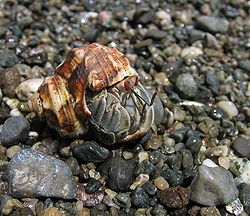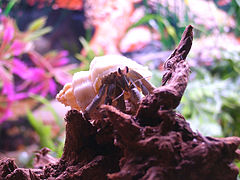- Ecuadorian hermit crab
-
Ecuadorian hermit crab 
Scientific classification Kingdom: Animalia Phylum: Arthropoda Subphylum: Crustacea Class: Malacostraca Order: Decapoda Family: Coenobitidae Genus: Coenobita Species: C. compressus Binomial name Coenobita compressus
H. Milne-Edwards, 1836The Ecuadorian hermit crab (Coenobita compressus) also known as the Pacific hermit crab is a species of land hermit crab. It is one of the two land hermit crabs commonly sold in North America, including the United States, as a pet, the other being the Caribbean hermit crab (Coenobita clypeatus).[1][2]
Contents
Features and identification
Coenobita compressus is a member of the phylum Arthropoda and the class Malacostraca. They can be up to 12mm in length and are thought to be one the smallest species of land hermit crabs. They have four walking legs, a small pincer, a large pincer, and antennae. Many people who keep these hermit crabs as pets notice that Ecuadorians can be relatively fast walkers, even faster than Caribbean hermit crabs, and that they are quite active. The eyes of Ecuadorians are more oval-shaped when compared to the round eyes of Caribbean hermit crabs and are thicker. Their big claw has 4 or 5 small ridges on the upper part. The tips of the second pair of walking legs are darker than the rest of the leg. The abdomen of the Ecuadorian hermit crab is short and fat.
Ecuadorian hermit crabs vary greatly in color, some are bright (yellow, dark grey, or orange), but more often they are a tan color. Sometimes they may have a blue or green tint to their bodies or the insides of their legs. They also have comma-shaped eyes, unlike the "purple pincher" (Coenobita clypeatus), which has dot shaped eyes.
When choosing a shell, they tend to give preference to shells with a wide and round aperture. As with all hermit crabs, painted shells are harmful to them, as they often eat the paint chips and can be poisoned with chemicals used in the paint. This significantly shortens their life span.
Habitats
Native to Ecuador and Chile, these hermit crabs live on the Pacific seashore around tidal pools and high-tide zone. Their bodies have adapted to this seashore existence and in captivity, they require access to seawater as they must metabolize the salt in it and bathe in it to maintain gill moisture. Failure to provide access to seawater (real or artificial) will result in death.
Like most hermit crabs they are scavengers and will consume seaweed, dead fish and other detritus that washes up on the shore.
Studies
Coenobita compressus prefers the odors of foods that they have not recently eaten.[3] The hermit crabs that were exposed to one food for at least 9 hours preferred foods having other odors for the next 6 hours. It is this short-term avoidance of food (like human beings who get bored with the same meals over and over again) that compels the crabs to seek out a wider range of food. This might be advantageous to the hermit crab, possibly through the consumption of a more nutritionally-balanced diet.
As pets
Hermit crabs overall were once seen as a "throwaway pet" that would live only a few months, but species such as Coenobita clypeatus has a 23 year lifespan if properly treated [4] and some have lived longer than 32 years.[5][6] Similarly Ecuadorian hermit crabs have been known to live to over 30 years. In general, and despite their moniker, hermit crabs are social animals that do best in groups.[7] They also require a temperature and humidity-controlled environment (ideally 70%-78%), and adequate substrate to allow them to bury themselves while molting.
References
External identifiers for Coenobita compressus EOL 4255404 NCBI 177221 WoRMS 368192 Also found in: Wikispecies - ^ Audrey Pavia: Hermit Crab PG.18 Retrieved July, 2009
- ^ Barren's: Hermit Crabs PG.9
- ^ Robert W. Thacker (1998). "Avoidance of recently eaten foods by land hermit crabs, Coenobita compressus". Animal Behaviour 55 (2): 485–496. doi:10.1006/anbe.1997.0621. PMID 9480714.
- ^ Land Hermit Crab Care Guide, Pet Smart, 2006, http://www.petsmart.com/uc/petarticles_db.jsp?ucCategory=CARE&ucTopic=FISH&ucSubTopic=CARE&ucSubTopic2=&ucContent=/articles/content/fish/care/hermit-crab/HermitCrabs.html
- ^ Lombardi, Linda (2008), "Hermit crabs can be fun, long-lasting pets", The Olympian (The Associated Press), http://www.theolympian.com/living/story/519995.html, retrieved October 2008
Alternate Citation: Lombardi, Linda (July 22, 2008), "Hermit crabs don’t have to fade away; with proper care they can have long life", Amherst Daily News (The Associated Press), http://www.amherstdaily.com/index.cfm?sid=155348&sc=510, retrieved July 2009 - ^ How Old Is My Hermit Crab?, crabstreetjournal.com, 2008, http://crabstreetjournal.com/xoops/modules/news/article.php?storyid=16, retrieved August 2008
- ^ Christa Wilkin (2004). "Basic crab care". http://www.hermit-crabs.com/care.html. Retrieved August 2008.
External links
Categories:- Hermit crabs
- Invertebrates of South America
- Pet crustaceans
- Animals described in 1836
Wikimedia Foundation. 2010.

